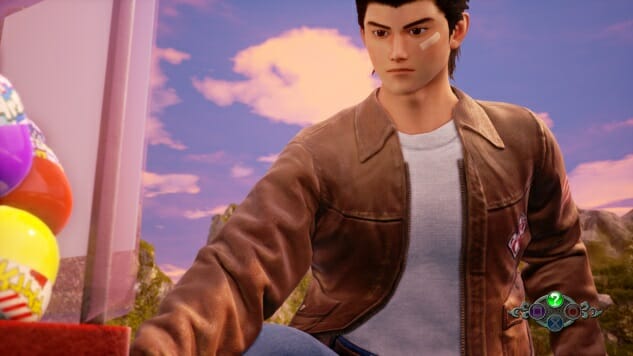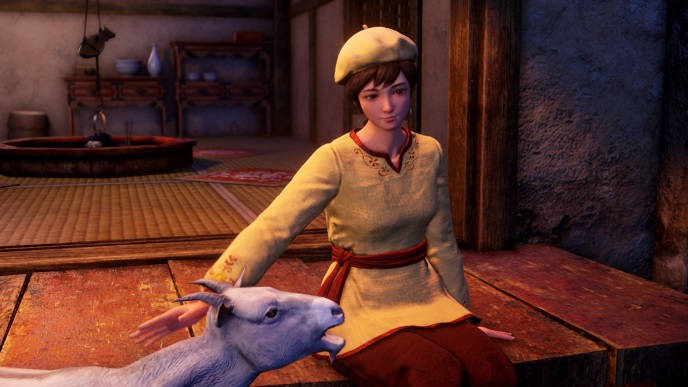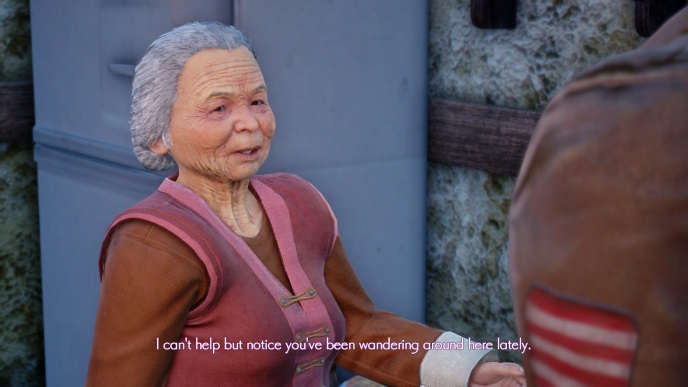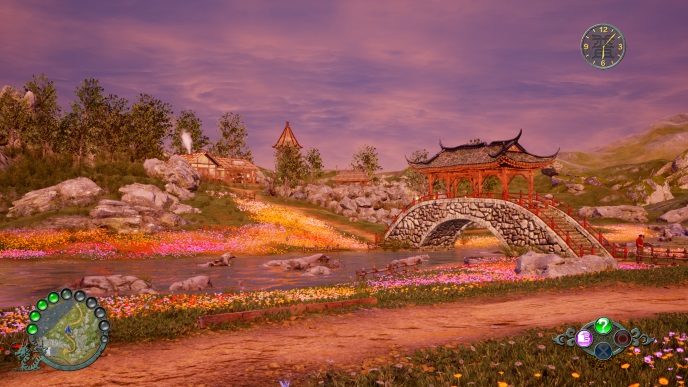
Nearly two decades later, Yu Suzuki returns to Shenmue with this third installment, and while most of videogames has picked the franchise’s bones clean, the vitality and expressive wonder in Shenmue III is indomitable.
Shenmue III is a haibun from a poet who is failed by language, a Buddhar?pa by a sculptor with only one blunted chisel. It is an expression of immensity, creativity, expertise—constrained.
It is neither failure, nor perfection. But also, Shenmue III doesn’t occupy some space in the middle. It is Shenmue.
But what does it mean to play Shenmue? What does Shenmue III feel like?
About 10 hours into Shenmue III, I became incredibly frustrated. My button presses grew harsh and forceful. The DS4 creaked in my hands from my grip tightening every time I got sent on a hike across town again. The circular, repetitive questioning with blunted affect. Having to chop wood, to buy food, so I could train my kung fu, or just simply exist. All of it hanging on me, weighing me down, making my progression through the game feel like more of a trudge than it already was. I felt like I was getting nowhere, that I’d lost any sense of narrative or even spatial progression.
9:30 PM rolled around and Ryo went back home to a modest house on the outskirts of Bailu, the sprawling village where Shenmue III spends about half its time.
Shenhua, Ryo’s companion since the end of Shenmue 2, greeted him in the kitchen.
And that’s when Ryo lost it.
Had a full on blow out. He was as sick of this shit as I was. I had a review deadline, he had a father to avenge, and together we were DONE with this drudgery of our shared lives.
Shenhua bid him to calm down. Life is this way sometimes. It may not be ideal, or what we want, but it’s what we have. Get some rest, come back to it tomorrow.
It was such a remarkable experience, I woke my partner up to tell them before falling fast asleep.

The next morning was much like it always is. I got up stiffly. Pulled on leggings, a hoodie, and a long puffy coat. I quietly placed my partner’s medications on the bedside table, and left for a walk. When I stopped to fish my cigarettes out of my purse, it was an automatic, reflexive gesture. I pulled out my phone and checked twitter as I finished my cigarette. It’s procrastination of a sort, I was not making “real” life progress. But it’s also the way I’ve found to get my mind and body ready to start the day.
Shenmue III mostly involves repeating a series of the same (or similar enough) actions. Daily.
You press X a lot. Sometimes Square.
It’s possible to game the systems. To plot out the ideal trajectory through the game, never keeping a Mastered Kung Fu move in your combo list to maximize skill growth. You can minimize waste and downtime by knowing which of the “minigames” to engage in and when and how. The limited fast travel can arguably save time. You can calculate the Yuan/Health ratio of every food and make economically perfect purchases. Shenmue III allows for this, the optimized life. In some ways, I wish I lived that way, I know real people who do, but I have never been one of them. I’m imperfect, I waste time, expend energy on things that I probably shouldn’t. I get distracted like a magpie, or Ryo walking past a gachapon machine.
Shenmue III understands this. It doesn’t judge. This is a valid way to live, a valid way to play. It even understands when our own limitations are the cause of our frustrations.
Stopping at Rite Aid on the return loop of my walk, I greeted the pharmacist with a smile.
“Hi. How are you today?”
“Good, you?”
“I’m fine, thanks. Do I have anything ready to pick up?”
“No, nothing’s ready until Wednesday.”
“Okay, thank you. Have a nice day!”
We followed the script we’re expected to. We do this every couple of weeks, but we don’t really know each other. It’s a socially templated interaction.
A lot of Shenmue III’s critical path is spent having perfunctory conversations with strangers. A clue leads to more questions leads to often basic relational conversations with locals (Ryo is an outsider, after all).
As with the original games, much can be criticized in the vocal performances in Shenmue III. They’re wooden, disjointed at times, often unintentionally comical or just plain awkward. Ryo will repeat the exact same question, the exact same way, to dozens of people. He has maybe a handful of ways he’ll strike up a conversation, mostly defaulting to a stiff, “Excuse me.”
Yes, the vocal performances (at least in English, I really don’t know enough Japanese to judge those performances, but it is toggleable from the main menu) are a far cry from the outstanding work players have come to expect (and frequently demand). It’s always jarring to hear three to four different pronunciations of the same non-English word, often by the same voice actor. The repetition of dialogue assets is painfully obvious at times. But, honestly? It works. It’s exactly what it needs to be and carries a meaningfulness beyond the apparent meme-ready chuckles.
As with my rote interaction with the pharmacist, we often operate on scripts. Repeating easily spooled-up greetings and bits of speech as social reflex. It alleviates the anxiety and potential for awkwardness or confusion in conversation, particularly with strangers. We take notice when people deviate from the scripts. Ryo is a stranger to nearly all of the people he interacts with. Many he’ll never see them again, and certainly has little if any intention of deepening a bond (if they even want that). The templated speech feels weird because it’s unexpected from a contemporary videogame, but it’s perfectly normal in our own lives.
Even so, the people Ryo encounters can and often do vary in disposition and response. Some are reserved or outright annoyed by his approach. Others are inquisitive, gosspy. Several older women in Bailu were all too eager to hear (and comment upon) Ryo’s living situation with Shenhua. Shopkeepers want you to buy something, and tradespeople are eager to discuss their craft. They’ll find Ryo’s hurry and lack of interest a negative. Some people want to share themselves with you. A young boy selling masks in the bustling port town of Niaowu offers, “Thank you, now I can eat” when Ryo buys a mask. It sticks out because it breaks the script, creates anxiety. It’s direct, but effective.

When I got home from my walk, I made coffee and breakfast. I sat next to my partner and we answered our emails, talked about our goals for the day, and then I settled in for a long day of playing Shenmue III.
That night I was up until 6 a.m. chopping wood. I hit a financial roadblock earlier. I needed to buy a 2,000 Yuan jug of wine. I needed to learn sick Kung Fu. I needed to appease a grandmaster, so he would teach me, against our better judgement, a single move to defeat a much tougher opponent.
There are shortcuts to making that kind of cash in Shenmue III. I could have (and I did fail trying) to gamble my way to riches in one of the several Venture Areas, playing a variety of minigames that mostly amount to pressing X and praying, or performing well in the occasional QTE sequence. In the end, I chose chopping wood at Uncle Tao’s general store.
In life, as in Shenmue, sometimes you just have to pick up shifts. Short cuts are for other people. You have to grind.
But the grind is tough. It takes time out of your day. Ryo needs to keep investigating the disappearance of his companion Shenhua’s father, solve the mystery of the Phoenix and Dragon Mirrors, he still needs to get vengeance against Lan Di for his father’s murder. But he also needs to train his proficient-but-not-otherworldly martial arts skills. And to do all of that takes money.
Thankfully, for the first half of the game anyway, lodging is free.
Shenmue III is less about revenge, and more about all the things that get in the way of achieving that goal. It’s simple enough to swap “get the man who killed my father” with any life achievement. Our lives are filled with goals and impediments, diversions and distractions, the things we have to do and the things we want to do that keep us going.
The Grind. Food. Shelter. Entertainment. Sleep. All the choices we have to make to fulfill those needs and desires are represented here. All crucial, but all subordinate to the flow of time.
Time is a persistence, a clock face forever in the upper right hand corner. Where Pathologic 2 made time an opponent, a harsh brutal nemesis that limited options and made every decision a panic-inducing hell—Shenmue III continues its understanding that time is just time. It passes with or without your action, each moment flowing into the next. Some minutes more charged than others. No other game I have ever played approaches time like Shenmue, which repeatedly tells Ryo (and players) — slow down. Don’t rush. Don’t pursue shortcuts. Embrace the flow of time for what it is.
Time as option, time as possibility, time as a measurement of life.

Shenmue III is fixated on life, but it’s not really a “Life Simulator.” Just as Shenmue III has largely abandoned the path towards more cinematic or dramatic aesthetics that modern games pursue relentlessly, it also ignores interest in replicating realism in the way “simulation” typically conveys. It’s not interested in being fun or having phenomenal gameplay.
When fights break out in Shenmue III (rarely, unless you’re sparring) they’re fast, floaty, weightless. They feel awkward compared to more competent brawlers or even similar, more action-oriented games like Yakuza. They’re rarely dramatic or even particularly interesting. And if you’ve ever been in a fight, you know that they tend to be over quickly and are difficult to find your bearings in (even if you’re winning). Ryo is quite proficient at martial arts, but he’s not a grandmaster. This isn’t an action movie. Spending time perfecting a combat system, making it deeper and more engaging and grounding it in a more physical way would make Shenmue play “better,” more “cinematic” or “realistic,” but it wouldn’t be a more truthful expression. As with the need to carry and eat food, or the mechanics of every minigame, realism is less of a focus. Ryo can subsist off of nothing but garlic bulbs stuffed in a jacket pocket, but he has to eat something. He can chop wood, but all the player does is press X at the right moment over and over. Ryo has a health meter that measures punches to the face, hunger, exhaustion, the progression of time—all of which can be “healed” by a good night’s sleep (or eating a dozen steamed buns).
These are the deliberate choices Shenmue III makes in service of its goal—emotional verisimilitude. Evoking an intangible truth, rather than manifesting strict realism.
This is the first thing I wrote down about Shenmue III:
THEY TALK LIKE FISH!
EVERYONE TALKS LIKE FISH!
THIS IS INCREDIBLE!
I’m referring to the facial animations. Mouths opening and closing like basking sharks, the cheeks puffing rhythmically like a pet goldfish gobbling at food flakes. Eyes like the deadened black marbles looking up from a fishmonger’s stall—still seemingly too perceptive. And the blunted affect of these faces mirrors the voice performances.
It’s unnerving, disorienting. It forces the reflexive laughter of being confronted by discomfort. Some will read this as an absurd anachronism, even a failure of budget and production. It is not.
On the day I finished playing Shenmue III, an old woodcutter explained to Ryo, “This town may have electricity and kerosene, but firewood is firewood.” It was the moment where not only did I feel I truly understood Shenmue’s place in not only gaming’s history, but why it needed to return, to persist in 2019.
Shenmue was a budgetary and technological marvel when it debuted in December, 1999.
It had to be.
For Yu Suzuki to achieve his goals, he needed at least the Dreamcast, all the creative and technical resources that Sega could muster, and 47 million dollars (a record breaker at the time). Games have taken a lot from Shenmue in the past 20 years. Our virtual worlds have become increasingly fully voiced, open, filled with fleshed out diversionary activities. Budgets, texture sizes, and polygon counts have all ballooned. There are games that strive for a complex simulations of reality, ones that steal as much as they can from cinema, and others still that hope to blend those ideals.
Shenmue III isn’t a flagship title from Ubisoft, EA or Activision. It’s not Red Dead Redemption 2. It won’t make you carefully balance an overloaded backpack to keep from toppling over like Death Stranding. Shenmue isn’t trying to advance the hyperrealistic technical experience of games. It’s not supposed to be a system bundle mover during Black Friday.

There’s a beauty to Shenmue III that I hope will not go unremarked on. A visual poetry that is simultaneously ungainly and stirring. Walking through the impressionistic fields of soft yellow and pink flowers in Bailu, seeing children practicing martial arts, all under the watchful ancient gaze of tremendous mountain ranges. Each person’s face in Shenmue feels unique (even when it’s not), emotive and full of life (even when gasping like a turtle). The framerate stutters at times, NPCs pop in unexpectedly, but the world feels alive, despite the limitations of budget and technology. It is genuine, honest. Opening a dozen drawers in Shenmue III is clumsy, awkward, and tedious. It showcases the limitations of the textures used, the lack of fluidity—but each trigger of the opening and closing animation is evocative. The emotional honesty of rummaging through a large dresser, which, when was the last time you thought deeply about what rummaging through a dresser even feels like? Shenmue III wants you to sit with those feelings.
In the hotel at the end of the game, there’s a guestbook on an end table. Inside of it are signed messages from Kickstarter backers. They range from the silly and weird (one person complaining that the hotel uses fiat currency and not cryptocurrency) to heartbreaking stories about relatives who have passed away. They span languages and ages, class and gender. The notes are elegiac, celebratory, and yes, nostalgic. Not a single one of them is well-written. They burst forth with emotion, but not prose style. They blaze with an uncontrolled rawness.
Will you like Shenmue III? I can’t say. This is likely the last new game I’ll play before the year ends, and it’s a sure win for my Game of the Year. Shenmue III spoke to me on a level few games have. I thought about giving it a 10/10, even began gearing myself up to argue that with my editor. But Shenmue isn’t perfect. It defies real perfection, because life is imperfect. Shenmue III is knobby and requires tremendous, repetitive effort before it gives up the special, unique warmth.
Firewood is firewood. Shenmue is Shenmue.
Shenmue III was developed by Neilo and Ys net and published by Deep Silver. Our review is based on the Playstation 4 version. It is also available for PC.
Dia Lacina is a queer indigenous writer, photographer, and founding editor of CapsuleCrit.com, a monthly journal dedicated to microgenre work about games. She tweets too much at @dialacina.